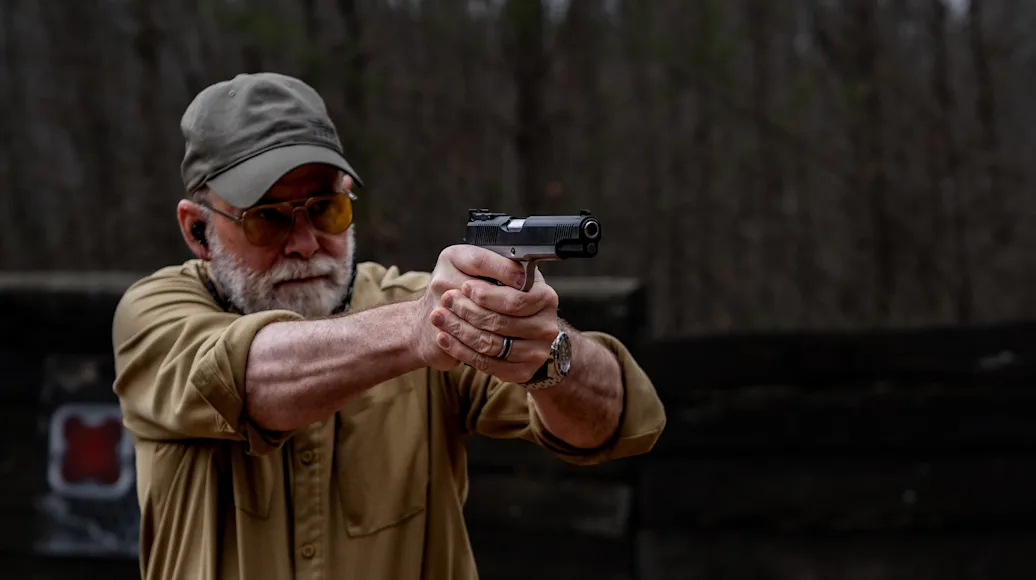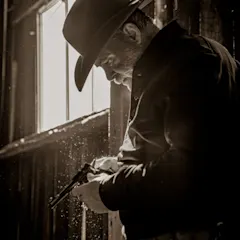_We may earn revenue from the products available on this page and participate in affiliate programs. Learn more ›
_
When most people think of a pistol, they think of a handgun similar to a Glock or a Colt 1911. But the Bureau of Alcohol Tobacco and Firearms (BATF) defines a pistol
—in part—as a firearm designed to be fired with one hand and with a barrel that has an integral chamber. This definition opens the category up to include a wide range of handguns that bear little resemblance to Glocks or 1911s. Here’s a complete guide to the different types of pistols and how they work.
Types of Pistols Overview
The are five different types of pistols based primarily on action type: semiautomatic, break-action, bolt-action, lever-action, and braced. Semiautomatic pistols can be broken down further by how their triggers work. And pistols in general can also be broken down by size, so we’ll start there.
Table of Contents
Types of Pistols by Size
Types of Pistols by Action
Types of Pistols by Use
Types of Pistols: Frequently Asked Questions
Types of Pistols by Size

Unlike with revolvers, the length of a pistol’s barrel includes the chamber. Richard Mann
Barrel length is the primary means for classifying pistols by size, and when it comes to pistols, the chamber is included in the barrel length measurement. Here’s how the different size categories break down based on barrel length:
Pocket Pistol: Less than 3 inches
Subcompact Pistol: Between 3 and 3.5 inches
Compact Pistol: Between 3.5 and 4.5 inches long
Full-Size Pistol: Longer than 4.5 inches
A full-size pistol often called a duty pistol, and the barrel is typically no longer than 6 inches. A handful of full-size pistols have barrels as long a 16 inches, but they’re normally intended for very specialized applications.
Typically, a pistol’s grip size is proportionate with its barrel length. Most full- or duty-size pistols have a large grip that fills the hand, and most pocket pistols have very small grips you can only wrap two fingers around. It gets a little confusing with compact and sub-compact pistols, because some manufacturers offer both with large and small grips. For example, the Glock G45
has a compact slide and barrel with a full-size grip, and Glock G43X
has a subcompact slide and barrel paired with a compact size grip. The upside is that you have more choices.
Types of Pistols by Action
Because the BATF’s definition of a pistol is so broad, a variety of handguns with different action types qualify. There are semi-automatic pistols, break-action pistols, bolt-action pistols, and even lever-action pistols. Some are single shots, some hold lots of ammunition, some really don’t look like they should be a pistol at all, but the only handgun that is not a pistol is a revolver
. So, let’s break down pistols by action type so you can see the differences.
Semiautomatic Pistols

Glocks are semiautomatic striker-fired pistols. Richard Mann
A semiautomatic pistol uses the recoil force of the fired cartridge to power the pistol’s slide to eject the empty case, load a fresh cartridge into the chamber, and to cock the hammer. With semiautomatic pistols there are some operational differences that mostly deal with the function of the trigger, and they can be broken down into four categories:
Single Action (SA) Pistol: The trigger’s only function is to release the hammer to make the pistol fire.
Double Action (DA) Pistol: A single press of the trigger on a DA pistol cocks the hammer and releases it to fire, but after the first shot, it functions like a SA pistol because the recoiling slide cocks the hammer.
Double-Action Only (DAO) Pistol: A DAO pistol is the same as a DA pistol, except the trigger cocks and releases the hammer for every shot and the hammer cannot be manually cocked.
Striker Fired (SF) Pistol: A striker fired pistol does not have a hammer. The trigger serves to release a pre-loaded/cocked striker, and it functions the same way for every shot fired.
Break-Action Pistols

A derringer is a break-action pistol that is typically used for personal protection. Richard Mann
The break-action pistol is best represented by the no-longer-manufactured but highly popular Thompson Center Contender. Break-action pistols are loaded by pivoting the barrel open on a hinge, just like a single-shot or double-barrel, break-action shotgun
. With the action open, a cartridge is inserted into the chamber/barrel and the action is closed. Break-action pistols are often chambered for rifle cartridges, but there’s a small two-barrel pistol called the derringer, and it can be chambered for revolver, pistol, or rifle cartridges—some even chamber and fire shotgun shells. Derringers, like those from Bond Arms
, bear little resemblance to a Glock pistol or Glock pistol alternatives
, but just like with other break-action pistols, their barrel(s) and chamber(s) are integral. Most derringers are very small, most often sized similar to pocket pistols.
Bolt-Action Pistols

Bolt-action pistols like this Nosler Model 48 are ideal for hunting or long-range shooting. Richard Mann
The best way to describe a bolt-action pistol is that it’s a bolt-action rifle with a stock that only has a pistol grip and a fore-end, and is therefore not designed to be fired from the shoulder. Bolt-action pistols are typically used for precision shooting at longer ranges, in the field or on the range. They’re also frequently chambered for rifle cartridges, and their receivers are drilled and tapped for scope bases so that a long eye relief pistol scope can be used. Though their stocks are designed to be gripped by one hand, bolt-action pistols are heavy, and you’ll struggle to shoot them without the support of a bipod or shooting sticks.
Lever-Action Pistols

Henry’s unusual Big Boy Mare’s Leg is a lever-action pistol and not a short-barreled rifle, as defined by the BATF. Richard Mann
This is an odd pistol. It was popularized by Steve McQueen’s character in the 1958 television series, Wanted: Dead or Alive, and is commonly called a “mare’s leg.” It’s nothing more than a lever-action rifle with a shortened barrel and a butt stock that’s also been shortened (so it’s not practical to shoot from the shoulder). But you’ve got to be careful here. Cutting up your lever-action rifle can get you into trouble with the BATF because of a thing they call a short barreled rifle (which we’ll get into next). You can buy a new mare’s leg lever-action pistol from Henry Repeating Arms
, but you might want to check the laws in your jurisdiction first.
Braced Pistols

Braced pistols, like this one from Ruger, are versatile firearms that up until the latest BATF ruling could be owned without additional regulatory requirements. Ruger
With the AR15’s rise in popularity, several manufactures began offering AR15 or similarly designed semi-automatic pistols with short barrels and no butt stock. These are a hoot to shoot but difficult to support by hand because they’re so heavy. To assist with this, the arm brace was invented. An arm brace extends to the rear of a pistol much like a butt stock, but it’s shorter, and its meant to be strapped to the forearm of the shooter’s arm. Because of the rigidity of these braces, they can also be used like a butt stock on a rifle.
This ran afoul of the BATF’s definition of a pistol, and they currently consider a braced pistol to be short-barrel-rifle (SBR) which is regulated the same way as suppressors. The BATF defines a SBR as, “a rifle having one or more barrels less than 16 inches in length and any weapon made from a rifle (whether by alteration, modification, or otherwise) if such weapon, as modified, has an overall length of less than twenty-six inches.” Currently, just exactly how braced pistols are affected by this BATF regulation is mired in court, and what is and is not legal today is about as clear as day-old coffee will be tomorrow.
Read Next: Types of Handguns: A Complete Guide
Types of Pistols by Use
We only touched briefly on the different things that pistols can be used for. Because they can be so different, they can be used for many different things. Some, like semiautomatics and derringers are ideal for personal protection. Others, like break- and bolt-action pistols, are well suited for competition and hunting. But most important, all typpes of pistol—regardless of their action or size—are great for recreational shooting.
Types of Pistols: Frequently Asked Questions
Is a relolver a type of pistol?
No. A revolver does not have chambers that are integral to the barrel, making it a handgun. All pistols must have a chamber that is part of the barrel.
What is a popular pistol?
It’s hard to say because because some pistols may be more popular than others based on the application. For example, Thompson Center pistols are popular for big-game hunting, Glocks are popular for self defense and sport shooting, and Ruger Mark IIs are popular for small-game hunting and plinking.
What are the two most common handgun categories?
At the most basic level, handguns can be broken down by pistols and revolvers. As said above, pistols have chambers that are integral to the barrel while a revolver’s chambers are separate from the barrel, contained in a revolving cylinder






